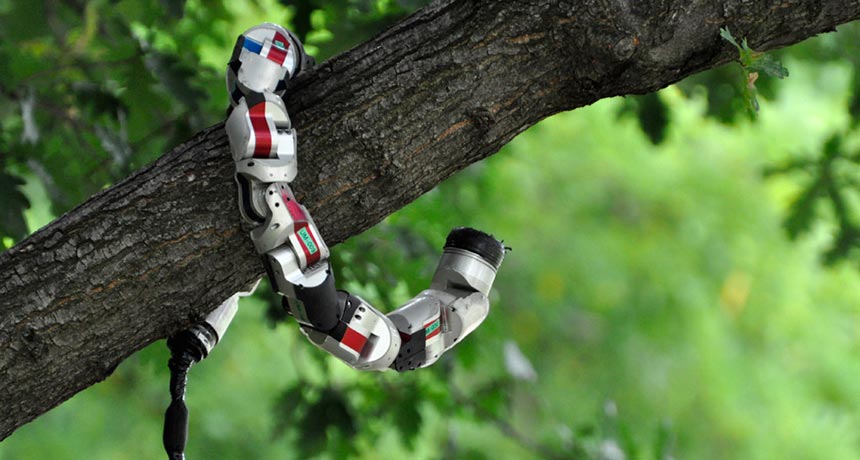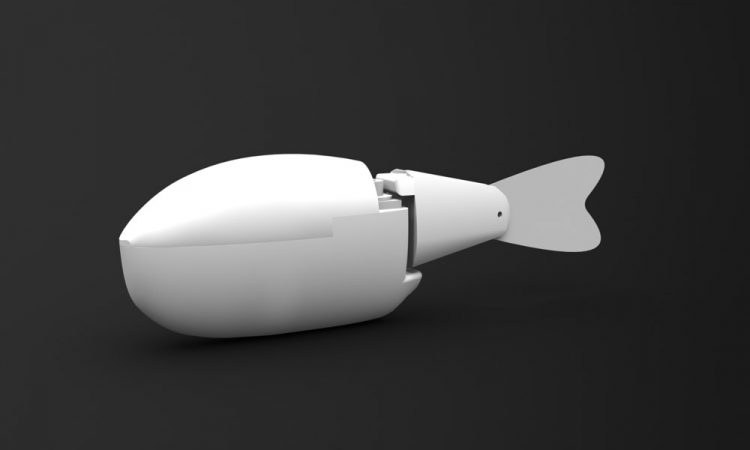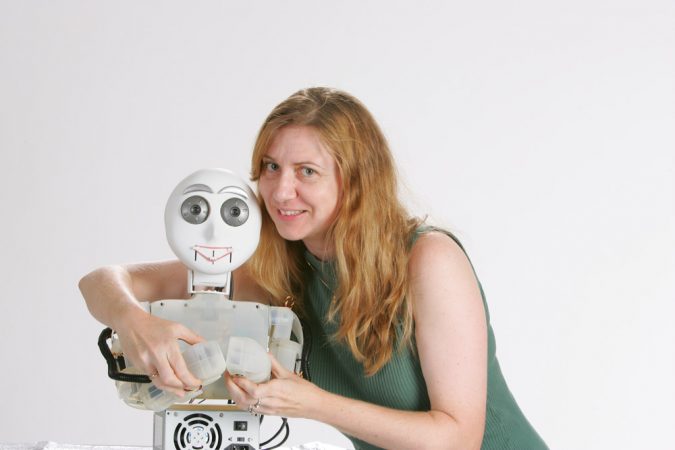Cool Jobs: Wide world of robots
The machines can help with everything from surgery to disaster response

Snake robots built by Howie Choset’s team can twist in many directions and move — slithering, swimming — like their namesake animal.
Howie Choset
By Roberta Kwok
When you think of robots, you might think of something like Wall-E — a machine designed to perform boring tasks, such as compacting trash.
But engineers today are making robots that can do much more interesting jobs. Robots shaped like snakes could one day search for victims after an earthquake or help doctors perform surgeries. Underwater robots might be able to lead fish away from environmental disasters. And humanlike robots could help people with diseases or physical disabilities.
Engineers who build and program robots have fascinating jobs. These researchers tinker with machines in the lab and write computer software to control these devices. “They’re the best toys out there,” says Howie Choset at Carnegie Mellon University in Pittsburgh. Choset is a roboticist, a person who designs, builds or programs robots.
Amazing snakebots
When Choset was a kid, he was interested in anything that moved — cars, trains, animals. He put motors on Tinkertoy cars to make them move. Later, in high school, he built mobile robots similar to small cars.
Hoping to continue working on robots, he studied computer science in college. But when he got to graduate school at the California Institute of Technology in Pasadena, Choset’s labmates were working on something even cooler than remotely controlled cars: robotic snakes. Some robots can move only forward, backward, left and right. But snakes can twist in many directions and travel over a lot of different types of terrain. “Snakes are far more interesting than the cars,” Choset concluded.
These snake robots can roll, inch forward, climb a person’s leg and even swim. Credit: Howie Choset
After he started working at Carnegie Mellon, Choset and his colleagues there began developing their own snake robots. A typical snake robot consists of a bunch of metal containers linked together, each with a motor and electronic parts inside. Choset’s team programmed robots to perform the same movements as real snakes, such as slithering and inching forward. The robots also moved in ways that snakes usually don’t, such as rolling. Choset’s snake robots could crawl through the grass, swim in a pond and even climb a flagpole.
The robots had another special feature: They could maneuver into tight spaces.
“Snakes go where we can’t,” says Choset. This feat could help save a life. For example, robotic snakes might be able to help find people trapped in collapsed buildings after earthquakes. It’s dangerous and difficult for rescue workers to search those buildings. But with a camera-equipped snake robot, rescue workers could scout for people in the rubble from a safe distance. With the help of search-and-rescue researchers, Choset has tested his robots in mock-collapsed buildings and rubble piles at a rescue-worker training site in Texas called Disaster City.
But Choset wondered if his snakes might be useful for medicine as well. For some heart surgeries, the doctor has to open a patient’s chest, cutting through the breastbone. Recovering from these surgeries can be very painful. What if the doctor could perform the operation by instead making a small hole in the body and sending in a thin robotic snake?
Choset teamed up with Marco Zenati, a heart surgeon now at Harvard Medical School, to investigate the idea. Zenati practiced using the robot on a plastic model of the chest and then tested the robot in pigs. He gave the pigs an anesthetic drug so they wouldn’t feel anything. Then he cut a small hole below the animal’s rib cage and inserted the “head” of a 30-centimeter-long snake robot. Using a joystick, Zenati made the robot move to the back of the pig’s heart. Then he threaded a surgical tool through the robot’s body and used that tool to perform an operation on the animal’s heart.
A company called Medrobotics in Boston is now adapting the technology for surgeries on people.
Snake robots could even be used to search for ancient artifacts. Choset is exploring the possibility of sending robots into Egyptian archaeological sites that are too small or dangerous for people to enter. A robot equipped with a camera could show scientists what is inside and perhaps even retrieve artifacts.
Even after 15 years of working with his team’s creations, “I still don’t get bored of watching the motion of my robots,” Choset says.
Follow the leader
Maurizio Porfiri, a mechanical engineer at the Polytechnic Institute of New York University, is also making robots that look like animals. But he has a different goal — to help the real animals.
Porfiri’s team builds robots that look like fish. These researchers want their machines to be convincing enough for real fish to accept the robot as part of their group. That way, the robot could lead the fish away from dangerous areas, such as oil spills.

Porfiri has always been interested in animals. When he was growing up, one of his favorite activities was going to the zoo. But he also liked the robots he saw in Japanese cartoons. So when he started his own lab, he decided to combine his two interests.
Scientists already know that fish swim in large coordinated groups called schools. Fish leading the school leave a wake, or an area of disturbed water behind them. Because it takes less energy to swim in another fish’s wake than to swim alone, many fish will follow the leaders, creating schools.
To find out if fish would accept a robotic leader, Porfiri’s team had to first build a fish-shaped machine. Its flexible tail can flap back and forth, propelling the robot forward. In order for real animals to interact with this device, the fish need to see something that looks like them and swims like them, explains Porfiri.
A real fish follows the robotic fish in a water channel. Credit: Polytechnic Institute of NYU
The researchers put the robot in a water channel in their lab and made the robot’s tail beat at different speeds. Then they added real fish called golden shiners and measured how much time the fish spent close to the robot. They also noted whether the fish swam in front of or behind the robot.
If the robot’s tail wasn’t beating, the fish didn’t pay much attention. But when the robot’s tail moved at a certain speed, fish began swimming behind it. Porfiri thinks the fish follow the robot because it makes swimming easier for them. “The fish like to ride the wake of the robot,” he says.
Not all fish followed the robot, though. Porfiri’s team is now trying to figure out why. Engineers might need to use several different robots, each attracting or repelling different fish, to lure as many followers as possible in the wild.
Porfiri’s team is also working on a robotic submarine that could help animals in captivity. A submarine with propellers on the outside could hurt the animals. So the researchers are developing a “safe” submarine that has all of its moving parts inside.
Trainers at an aquarium could use the robotic submarine to play with animals such as seals or walruses. For example, the trainer could attach food to the submarine and let the animals “hunt” for it, the same way they hunt for prey in the wild. Captive animals with lives that are more similar to those of wild animals are better off.
Robots with a personality
When Maja Matarić was in high school, she wrote a computer program that “talked” back to a person. The user could type a message into the computer, and the program would display a reply.
Now a roboticist at the University of Southern California in Los Angeles, Matarić is leading a team that programs machines called socially assistive robots. These devices can talk, make gestures and move around.

Matarić wants her team’s robots to help people who have diseases or physical disabilities. For example, a person with Alzheimer’s disease, which causes problems with memory and brain function, might need help with mental exercises. A person trying to regain the use of an arm after a stroke might need encouragement to keep doing helpful exercises.
Because there are not enough people to provide all of the help that’s needed, says Matarić, “technology has to step in.”
In one study, Matarić’s team tested a robot with people recovering from a stroke. A stroke is caused by a broken blood vessel in the brain or a blood clot that prevents blood from flowing to the brain. Small regions of cells die during a stroke. So afterward part of the body, like an arm, may become weak or numb. A patient has to keep exercising that arm to recover. Those exercises can be difficult and unpleasant, however.
Matarić and her colleagues programmed a knee-high robot to ask a patient to perform an exercise and to then monitor the patient’s movements. If the person actively used his or her arm, this robot would say encouraging things.
The team tested the robot with six people actually recovering from a stroke. Patients tended to perform their exercises longer and follow instructions better when the robot was present than with no prompting.
Next, the researchers tested whether the robot’s personality affected how people responded to it. The robot could be directed to move in close, speak loudly and make forceful statements, such as “You can do it!” Other times, the researchers would program the robot to act more shyly. At these times, the robot kept a bit of a distance and softly offered gentle suggestions, such as “I know it’s hard, but remember it’s for your own good.”
In this study, healthy adults performed exercises using their weaker hand. The tasks were similar to those done by patients working to recover from a stroke, such as moving pencils or turning newspaper pages. People practiced their task longer when the robot’s personality was similar to their own, the team found.
Matarić is also working on robots to help children with brain problems known as autism spectrum disorders. Children with these conditions have trouble communicating and interacting with people. Matarić hopes a robot might help these kids practice their social skills. And one big advantage of a robot over people: It never gets tired or frustrated or angry.
The team designed and programmed a 3-foot-tall, humanlike robot called Bandit that can make noises, move around, wave and blow bubbles. In one study, the researchers watched how eight children with autism spectrum disorders reacted to Bandit. Some kids seemed to like the device: They talked to the robot, played with it and tried to get the machine to follow them. Other kids seemed uncomfortable, perhaps because of the sounds made by Bandit’s motors. These kids backed away from the robot and stayed close to their parent or against a wall.
Matarić’s team is now working on improving Bandit so that the robot can tell if the child is having a good reaction or a negative one. For example, if the child is hiding against the wall, Bandit might back away, make an encouraging noise or just shut down its motors.
A robot named Bandit can make noises, move around, wave and blow bubbles. Credit: Maja Matarić, USC
Matarić, Choset and Porfiri are just a few of the many engineers working on robots today. Whether you want to create robots that explore the ocean, travel to outer space, help elderly people or perform medical procedures, “There’s just no limit to what we can do in this field,” says Matarić.
Power Words
robot A machine that can sense its environment, process information and respond with specific actions. Some robots can act without any human input, while others are guided by a human.
artifact An object made by people.
wake An area of disturbed water left behind an object moving through the water, such as a boat or swimming animal.
autism spectrum disorders A set of developmental disorders characterized by problems with social interactions and communication
This is one in a series on careers in science, technology, engineering and mathematics made possible by support from the Northrop Grumman Foundation.







